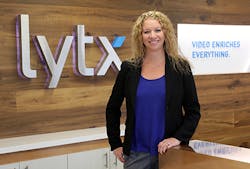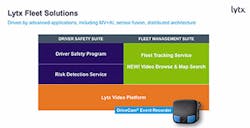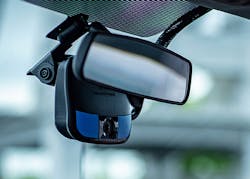Lytx Empowers Optimal Fleet Visibility Through Video Telematics
by Terry McIver, with supporting information previously provided by Lytx
For the daily commuter, “safe driving” means “don’t get a ticket, and don’t have an accident.” But for a service business fleet manager, “safe driving” is linked to more than a dozen vehicle-related issues, including: safety as a part of company culture, timely service delivery, company reputation management, employee engagement, fleet maintenance, driving efficiency and cost savings.
An unmonitored vehicle or fleet ventures out into the streets each day electronically "untethered," with no system of accountability to help guide or monitor drivers’ behavior. Back at the office, it’s anybody’s guess what’s happening “out there” related to safety, job progress and unsafe driver activity.
About 20 years ago, the onset of “video telematics” began to change all that, for the good of drivers, fleet managers, service customers and the commuting populace.
Lytx — a pioneer and leading global provider of video telematics, analytics, productivity and safety solutions for commercial, public sector and service fleets — has spent those 20 years working to improve driver safety, which is the key to protecting a service business’s bottom line. Linked tightly to safe driving are lower overhead costs, company image, public safety, and employee retention.
Lytx empowers optimal fleet visibility and operations through the power of video telematics. Its goal is to identify, capture and deliver driving data for myriad fleets, large or small, which fleet managers then use to foster improved driver safety and awareness, in addition to improved scheduling, routing and customer service through fleet tracking.
Lytx has been improving its award-winning, superior MV+AI solution — Machine Vision plus Artificial Intelligence — for more than a decade. The company first released MV+AI in 2015 to help fleets identify risky driving behavior, like unsafe following distance. The most recent enhancements, launched this past February, include ability to recognize and tag inside-the-cab-view “trigger” activities, such as cell phone use, powered by MV+AI to help solve the epidemic of distracted driving, a problem that costs approximately $175 billion a year in the United States.
“While many providers claim to have AI, it is really important to ask the right questions about the quality and breadth of their offering because many providers only capture one or two specific behaviors and do so using unreliable or limited datasets,” said Dave Riordan, Lytx executive vice president and general manager, enterprise business. “This can lead to a barrage of false positives that result in inaccurate data and lead to trust issues with drivers, while increasing the risk of missing the real thing. We are pleased to see so many fleets adopting our MV+AI technology, enabling them to detect and reduce cell phone use and other high-risk driving behaviors before they result in a collision – or worse.”
Kristin Costas, Lytx’s Director of Product Management, said fleet managers who have selected Lytx video telematics are very customer-centric, which encompasses concerns related to complaints about drivers, driver service efficiency, and everything else that plays a role in package deliveries or service calls, and most importantly, safety.
MV+AI detects and alerts drivers and fleets of distractions and risky behaviors in real-time
A new enhancement was announced in July 2020, when Lytx revealed new data on how its machine vision and artificial intelligence (MV+AI)-powered technology has enabled fleets and empowered drivers to identify and correct significantly more risk, both inside and outside of the vehicle.
“Lytx’s advanced MV+AI solutions make it easier for fleets to get started with and benefit from AI,” said Sathya Kabirdas, Research Director, Frost & Sullivan. “Lytx is at the forefront of machine vision- and artificial intelligence-based video telematics for commercial vehicle fleets. The company has consistently delivered innovative technology in advance of the market and moved the space from speculating about the potential of MV+AI to deploying it at a scale that is helping transform safety and productivity for fleets of all sizes, across all industry segments.”
Sources report there is a large amount of enthusiasm for Lytx’s proven MV+AI solution among current customers and that it is rapidly expanding to new users. Since launching its inside view triggers in February 2020, over 1,500 more fleets have deployed the company’s MV+AI-backed driver safety solution, actively and accurately detecting high-risk behaviors among their drivers in real-time, whileIn addition to safety benefits, fleet video improves fleet tracking, productivity and service delivery.
“We believe video enriches everything. It obviously plays a role in safety; so you can see exactly what’s going on with the driver, and the behavior they exhibit,” Costas said. “But we have also seen the value of video related to productivity, fleet tracking and service delivery. A picture is worth a thousand words. We take this approach, as we apply video to most everything we do.”
Visibility Inside Vehicle and Out
Lytx technology is validated and backed by the largest and fastest-growing driving database of its kind, which grows by more than 140,000 new driving events each day, further training and improving its algorithms. This data is incorporated into a system that is able to deliver greater than 95% accuracy across 60 behaviors – unmatched by competitors in the industry, Lytx reports. Over its history, MV+AI is powered by 120 billion miles analyzed, 600,000 connected vehicles, more than 50 billion MV+AI objects daily and 150 million human-validated video clips.
- No seat belt — identified 397% more
- Unsafe following distance — identified 332% more
- Incomplete stop – identified 243% more
- Food or drink — identified 173% more
- Failure to stop — identified 188% more
- Handheld device — identified 133% more.
Lytx calculates that 35% of all near collisions captured by its devices involve one or more of the above-listed behaviors. This underscores both the prevalence of those behaviors, the risk they present, and in turn, the power of proactively capturing these habits – enabling driver self-correction in real time and the potential for deeper coaching in the future.
Lytx field service customers include utility crews, HVAC and plumbing, package delivery and construction.
"There are many different segments and ‘field services’ is the term we apply to fleets where the drivers are not referred to as 'drivers' — they drive to arrive at their core job: whether it be HVAC, plumbing, delivery services, and others. Those service fleets come with their own specific problems. For the past couple of years we''ve focused on addressing those types of fleets, and on how we can build products to help them specifically,” Costas said.
"We want to be sure we have support mechanisms for our customers to be able to do their work, and to serve the industry in which they exist. So whether it be trucking or field services, or technicians going out to do plumbing or HVAC work; we want to ensure they can do those things efficiently, and leverage this technology to improve their companies’ bottom line; to make sure we’re dispatching drivers and technicians to appointments, not spending too much time there, and that the customers are satisfied with their local service."
Driver Safety + Fleet Management
Lytx Fleet Solutions, driven by advanced applications, including MV+AI, sensor fusion and distributed architecture, consists of a Driver Safety Suite and a Fleet Management Suite.
The Driver Safety Suite is comprised of a Driver Safety Program and Risk Detection Service. “These are two different safety offerings that basically allow a fleet to start uncovering the risk that exists within their operations,” Costas explained. “The risk detection service leverages algorithms and sensors on the device to look for and identify certain types of risk, including hard braking, cornering, and accelerating. Then, as you get into the machine vision, we can identify when the driver is on the cellphone or is distracted because they’re eating food or not wearing a seatbelt. We have many algorithms informed by years and billions of miles analyzed which have allowed us to create these algorithms to detect these things in real time, to quickly identify the risk event within the fleet and powering that fleet to take action on it.”
• The Driver Safety Program empowers fleet managers to use coaching as a proactive approach to address driving risks.
• Risk Detection is a basic safety service, identifying the risk and presenting it to the manager who then decides what action to take.
• The Driver Safety Program comes with a constructed “workflow,” which managers use to identify a risk for the driver and provides a learning task to coach the driver and make them better drivers over time.
Good Intentions
Although this equipment is designed to monitor driver behavior, Costas wanted to emphasize that it's all focused on a favorable outcome.
"We’ve worked to make this a tool the driver can engage with and use as a benefit. We’re trying to reduce risk and prevent collisions; and we have many examples of drivers being skeptical at the launch of their organization deploying our technology. But over time, as they see how it’s used, they appreciate the fact that it’s helping them to become better drivers. We even have some examples of drivers moving fleets and asking for our technology, and not wanting to get into a cab without it.
"Because it can often serve to exonerate a driver. Imagine a driver getting into a collision while driving a vehicle covered with the company logo. Some people will try to take from deep pockets."
Fleet Tracking
Costas said Lytx has consulted many hours with fleet managers to learn those details they want to see in "real time" viewing mode. One is to identify different types of vehicles, by individual vehicle or by group. Various defaults area available, including color coding, or tracking only certain vehicles inside a specified driving radius.
"If you have a very large fleet it’s overwhelming to see them all at one time, so maybe you want to view only the vehicles that are closest to you inside a 20-mile radius. There are many different cases with a solution like this, so we try to make it as configurable as possible without being overwhelming."
Vehicles can also be plotted according to addresses or proximity to landmarks.
In History Mode, a fleet manager can see the travel history of a vehicle from the previous day, including speed, status and address location.
The Lytx fleet tracking feature generates reports to help identify fleet efficiency and where is there room for improvement.
"This involves balancing safety and productivity," Costas said. "You can’t start taking a stab at that without data to inform your decisions. So, we decide to uncover the risks that exist and show productivity through metrics. We can see, on average, the route time and total time used for different trips, for the past 30 days or week. "Many fleet managers are concerned about stop time. If I can assume stop time is when driver arrives and then leaves, I can get an idea of time required."
About the Author
Terry McIver
Content Director - CB
As director of content for Contracting Business, he produces daily content and feature articles for CB's 38,000 print subscribers and many more Internet visitors. He has written hundreds, if not two or three, pieces of news, features and contractor profile articles for CB's audience of quality HVACR contractors. He can also be found covering HVACR industry events or visiting with manufacturers and contractors. He also has significant experience in trade show planning.




